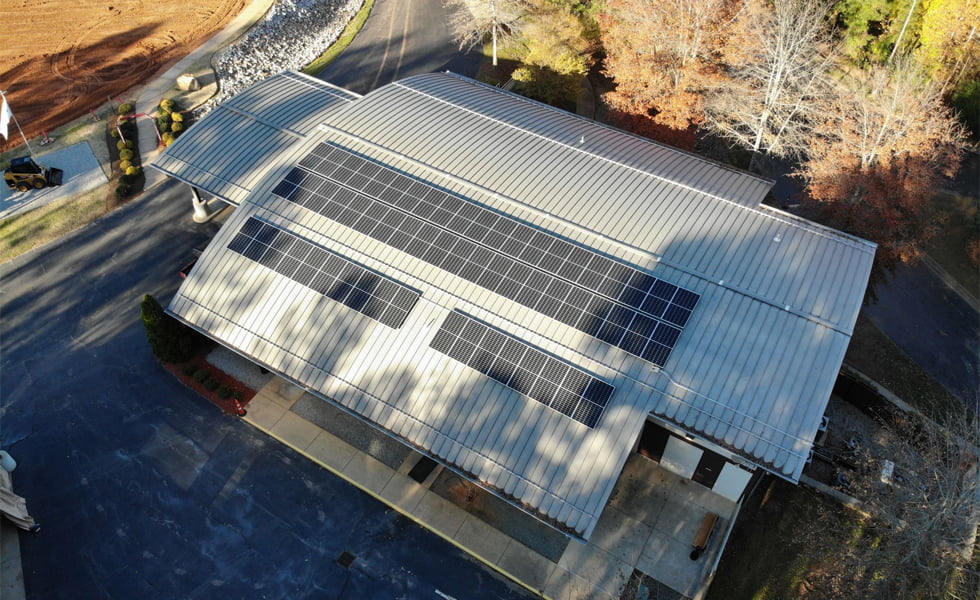
The vertical tilt, or angle, at which the solar panels are installed in a photovoltaic system will have an impact on the amount of electricity they can generate.
A panel will collect solar radiation most efficiently when the sun's rays are perpendicular to the panel's surface – however the angle of the sun varies throughout the year. The optimal tilt angle for a solar panel will differ throughout the year, and will also vary by latitude.
How tilt angle affects performance?
The optimal tilt angle is not one-size-fits all.
The natural tilt and orbit of the earth around the sun influence the way the sun moves across the sky in different locations around the world and at different times of the year. The geographical latitude of a solar installation determines the vertical angle at which the panels should be installed to generate the most energy from the sun’s rays hitting the surface.
Solar panels that are not tilted would be installed parallel to the ground, while panels at a 90° angle would stand upright.
But it is not just the position of the sun that affects solar electricity output.
The angle that solar panels are installed also determines the effect of climatic and environmental conditions. In regions closer to the poles, accumulation of snow on panels during the winter can block sunlight from reaching optimal levels. The solution? A higher tilt angle can limit the amount of snow and ice that accumulates on the surface of the panels by allowing snow and rainfall to slide off. The tilt can also limit soiling from dust, sand and dirt in dry, polluted or desert areas that can block sunlight and reduce energy conversion.
What is the right tilt angle for optimal output?
As a general rule, to achieve the optimal energy production annually, the tilt angle for solar panels should be the same as the site’s geographical latitude. If a solar array is located at a latitude of 50°, the optimal tilt angle would also be 50°. The further the location is from the equator and the closer to the poles, the higher the tilt should be for the panel to face the sun.
With fixed structures, the tilt puts the PV modules at the angle that will give them the most direct sunlight from the sun’s changing position throughout the day.
But tilting rows of solar panels creates shading of the adjacent parallel rows, which partially obstructs their exposure to direct sunlight. And when even one cell in a crystalline PV module is shaded, it reduces the entire module’s electricity generation. For utility-scale projects, even a small degree of shading can result in sizable production losses.
The key to optimizing a project is to increase the distance between parallel rows of panels without excessively increasing the overall size of the installation site. A ground-mounted system that is too large increases the cost of the land needed and may not be viable for sites where the extra land is not available. And roof-mounted systems are limited to the usable area of the building’s rooftop. Spacing panels too far apart reduces the number of panels that a rooftop or piece of land can accommodate and produces less electricity.
This is one way in which Rated Power’s pvDesign modeling software can ensure a large-scale plant achieves optimal output. In pvDesign, the recommended tilt angle for fixed structures is calculated based on the site latitude. If the latitude is below 5°, the recommended tilt is 5°. For latitudes between 5° and 10°, the tilt recommended is equal to the latitude. For latitudes between 10° and 20°, the recommended tilt is equal to the latitude multiplied by 0.9 and for higher latitudes above 20°, the tilt is recommended to equal the latitude multiplied by 0.85.
How backtracking minimizes tilt shading?
Solar panel backtracking uses a motor and tracking control program that adjusts the tilt of the panels as the sun moves across the sky throughout the day and the year. This maximizes the direct sunlight that reaches the panel from the sun’s path by reducing the shading from the adjacent rows of panels to limit production losses.
While adjusting the angle of the panels to prevent shading may shift their surfaces away from the optimal angle for direct sun rays, the loss in generation is less than the system would lose from the rows of panels being shaded.
Panel backtracking results in more efficient electricity generation than solar energy systems with fixed structures. But it is important to note that as it requires motors to adjust the tilt of the panels, it is more expensive to install and has more equipment parts to maintain than fixed structures. Backtracking is typically used in locations where levels of direct sunlight are higher than diffuse sunlight, so that adjusting the tilt of the panels produces enough additional electricity to justify the investment.
In pvDesign, backtracking tilt is calculated to give the angle that provides the highest electricity output while producing the least amount of shading on adjacent rows. The structures are designed to adjust from east to west following the sun’s path during the day, with the axial direction for trackers set in the north to south direction.
The algorithm is based on the pitch distance the user defines, as the limiting angle for the backtracking depends on the pitch between panel rows to avoid shading between structures.
